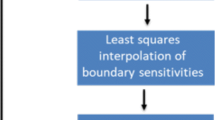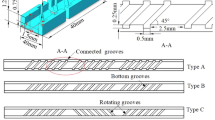Abstract
This paper proposes an optimal design method for plate-type microchannel reactor manifolds, using a level set-based topology optimization method that targets flow uniformity among the microchannels. For plate-type microchannel reactors, manifold designs must consider both the uniformity of flow among the microchannels and minimization of pressure drop in the device. To address these design requirements, the pressure drop in the device is defined as the objective functional to be minimized under a flow rate inequality constraint, defined as the deviation in flow rate among the microchannels during the optimization. In addition, we propose a comparably simple and stable augmented Lagrangian method using an exponential function, to determine the Lagrange multiplier that acts to satisfy the flow rate inequality constraint. To demonstrate the utility of our proposed method, two-dimensional Z-type and U-type manifold design problems are presented in the numerical examples.






















Similar content being viewed by others
References
Aage N, Poulsen TH, Gersborg-Hansen A, Sigmund O (2008) Topology optimization of large scale Stokes flow problems. Struct Multidisc Optim 35(2):175–180
Allaire G, Jouve F, Toader A (2004) Structural optimization using sensitivity analysis and a level-set method. J Comput Phys 194(1):363–393
Allaire G, Gournay F, Jouve F, Toader AM (2005) Structural optimization using topological and shape sensitivity via a level set method. Control Cybern 34(1):59–81
Bajura RA (1971) A model for flow distribution in manifolds. J Eng Power Trans ASME 93(1):7–12
Bajura RA, Jones EH (1976) Flow distribution manifolds. J Fluids Eng Trans ASME 98(1):654–666
Bassiouny MK, Martin H (1984a) Flow distribution and pressure drop in plate heat exchangers-I U-type arrangement. Chem Eng Sci 39(3):693–700
Bassiouny MK, Martin H (1984b) Flow distribution and pressure drop in plate heat exchangers-II Z-type arrangement. Chem Eng Sci 39(3):701–704
Bendsøe MP, Kikuchi N (1988) Generating optimal topologies in structural design using a homogenization method. Comput Methods Appl Mech Eng 71(2):197–224
Bendsøe MP, Sigmund O (1997) Optimization of Structural Topology, Shape and Material. Springer, Berlin
Borrvall T, Petersson J (2003) Topology optimization of fluids in Stokes flow. Int J Numer Methods Fluids 41(1):77–107
Bruns TE (2007) Topology optimization of convection-dominated, steady-state heat transfer problems. Int J Heat Mass Transfer 50(15–16):2859–2873
Challis VJ, Guest JK (2009) Level set topology optimization of fluids in Stokes flow. Int J Numer Methods Eng 79(10):1284–1308
Deng Y, Liu Z, Zhang P, Liu Y, Wu Y (2011) Topology optimization of unsteady incompressible Navier-Stokes flows. J Comput Phys 230(17):6688–6708
Deng Y, Liu Z, Wu J, Wu Y (2013) Topology optimization of steady Navier-Stokes flow with body force. Comput Methods Appl Mech Eng 255:306–321
Diaz AR, Kikuchi N (1992) Solutions to shape and topology eigenvalue optimization problems using a homogenization method. Int J Numer Methods Eng 35(7):1487–1502
Duan XB, Ma YC, Zhang R (2008) Shape-topology optimization for Navier-Stokes problem using variational level set method. J Comput Appl Math 222(2):487–499
Eschenauer HA, Kobelev V, Schumacher A (1994) Bubble method for topology and shape optimization of structures. Struct Optim 8(1):42–51
Gersborg-Hansen A, Sigmund O, Haber RB (2005) Topology optimization of channel flow problems. Struct Multidisc Optim 30(3):181–192
Gersborg-Hansen A, Berggren M, Dammann B (2006) Topology optimization of mass distribution problems in Stokes flow. Springer, Netherlands, pp 356–374
Hassan JM, Mohammed WS, Mohamed TA, Alawee WH (2014) Review on Single-Phase Fluid Flow Distribution in Manifold. Int J Sci Res 3(1):325–330
Hestenes MR (1969) Multiplier and gradient methods. J Optim Theory Appl 4(5):303–320
Liu Z, Gao Q, Zhang P, Xuan M, Wu Y (2011) Topology optimization of fluid channels with flow rate equality constraints. Struct Multidisc Optim 44(1):31–37
Ma ZD, Kikuchi N, Cheng HC (1995) Topological design for vibrating structures. Comput Methods Appl Mech Eng 121(1–4):259–280
Matsumori T, Kondoh T, Kawamoto A, Nomura T (2013) Topology optimization for fluid-thermal interaction problems under constant input power. Struct Multidisc Optim 47(4):571–581
Mohammadi M, Jovanovic GN, Sharp KV (2013) Numerical study of flow uniformity and pressure characteristics within a microchannel array with triangular manifolds. Comput Chem Eng 52:134–144
Nishiwaki S, Frecker MI, Min S, Kikuchi N (1998) Topology optimization of compliant mechanisms using the homogenization method. Int J Numer Methods Eng 42(3):535–559
Olesen LH, Okkels F, Bruus H (2006) A high-level programming-language implementation of topology optimization applied to steady-state Navier-Stokes flow. Int J Numer Methods Eng 65(7):975–1001
Osher S, Sethian JA (1988) Front propagating with curvature dependent speed: algorithms based on Hamilton-Jacobi formulations. J Comput Phys 78(1):12–49
Otomori M, Yamada T, Izui K, Nishiwaki S (2015) Matlab code for a level set-based topology optimization method using a reaction diffusion equation. Struct Multidisc Optim 51(5):1159– 1172
Pan M, Tang Y, Pan L, Lu L (2008) Optimal design of complex manifold geometries for uniform flow distribution between microchannels. Chem Eng J 137(2):339–346
Rockafellar RT (1973) A dual approach to solving nonlinear programming problems by unconstrained optimization. Math Program 5(1):354–373
Sigmund O (1997) On the design of compliant mechanisms using topology optimization. Mech Based Des Struct Mach 25(4):493–524
Sigmund O, Petersson J (1998) Numerical instabilities in topology optimization: A survey on procedures dealing with checkerboards, mesh-dependencies and local minima. Structural Optimization 16:68–75
Sokolowski J, Zochowski A (1999) On the Topological Derivative in Shape Optimization. SIAM J Control Optim 37(4):1251–1272
Suzuki K, Kikuchi N (1991) A homogenization method for shape and topology optimization. Comput Methods Appl Mech Eng 93(3):291–318
Tonkovich A, Kuhlmann D, Rogers A, McDaniel J, Fitzgerald S, Arora R, Yuschak T (2005) Microchannel technology scale-up to commercial capacity. Chem Eng Res Des 83(A6):634–639
Tonomura O, Tanaka S, Noda M, Kano M, Hasebe S, Hashimoto I (2004) CFD-based optimal design of manifold in plate-fin microdevices. Chem Eng J 101(1–3):397–402
Wang MY, Wang X, Guo D (2003) A level set method for structural topology optimization. Comput Methods Appl Mech Eng 192(1–2):227–246
Yaji K, Yamada T, Yoshino M, Matsumoto T, Izui K, Nishiwaki S (2014) Topology optimization using the lattice Boltzmann method incorporating level set boundary expressions. J Comput Phys 274:158–181
Yamada T, Izui K, Nishiwaki S, Takezawa A (2010) A topology optimization method based on the level set method incorporating a fictitious interface energy. Comput Methods Appl Mech Eng 199(45–48):2876–2891
Zhou S, Li Q (2008) A variational level set method for the topology optimization of steady-state Navier-Stokes flow. J Comput Phys 227(24):10,178–10,195
Author information
Authors and Affiliations
Corresponding author
Rights and permissions
About this article
Cite this article
Kubo, S., Yaji, K., Yamada, T. et al. A level set-based topology optimization method for optimal manifold designs with flow uniformity in plate-type microchannel reactors. Struct Multidisc Optim 55, 1311–1327 (2017). https://doi.org/10.1007/s00158-016-1577-0
Received:
Revised:
Accepted:
Published:
Issue Date:
DOI: https://doi.org/10.1007/s00158-016-1577-0




